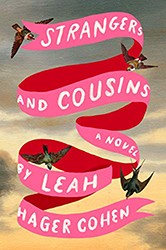Jewish immigration from Eastern Europe to the United States is often viewed as a mass experience, but each immigrant was a unique individual. As in any part of the world, shtetl Jews had different talents, hopes, and dreams. In Nathan’s Song, based on the life of Leda Schubert’s grandfather, Nathan is not a Talmud scholar or a future entrepreneur. Instead, he is gifted with a beautiful voice, and he longs for the opportunity to train as a professional vocalist. In fact, he hopes to study in Italy, the country that he associates with the highest classical standards in his field. This picture book is a refreshing portrait of a young Jew dedicated to his art, whose supportive family and a certain amount of luck lead to a rich and fulfilling life in America.
Nathan is the boy in the village who can sing in any situation: peeling potatoes, stacking wood, bringing water from the well. No one in his community expects Nathan to pursue his vocation as a career but they know that “He can lift your heart with his voice.” In addition to liturgical singing, Jews have always enjoyed a deep connection to folk music that reflected their own experiences. Nathan seems to be versatile enough to sing anything. But when he is fortunate enough to hear a concert by a professional opera singer, he knows that he must pursue this dream. Instead of discouraging his impractical plans, Nathan’s parents actually support him, insisting that they will find the money for his travel to Italy. The good fortune of having a loving and idealistic family is the beginning of Nathan’s winding journey.
As in many immigrant narratives, Nathan encounters some unexpected obstacles. He boards the wrong ship and ultimately lands in New York City. There is a certain fairy tale quality to this unforeseen turn, which leads to initial setbacks but finally to success. Yet each detail of the story removes it from the level of myth and grounds it in reality. Nathan finds a job making hats, not working in an opera house. He keeps singing to himself while working. An Italian gentleman named Nicolo hears him and offers to give him lessons. This wonderful working relationship does not lead to the great opera houses of the world, but rather to a different rewarding career: “So Nathan sang his beloved opera in restaurants, and at weddings, and even in small theaters.” Eventually, his patience and gratitude lead to “a big Broadway stage.” At the same time, a lovely woman named Sonia comes into the hat shop where Nathan works and, before long, they are married. Nathan needs more than recognition of his voice to be content.
Maya Ish-Shalom’s illustrations use colorful geometric figures and careful design to create the perfect stage for Nathan’s life. One picture features three portholes on a grand ship through which the reader views the “glittering captain’s table” and “ladies and gentlemen with their diamonds.” Nathan serenades them, hands on his heart, while musical notes emerge into the air. In New York City, rectangular skyscrapers dwarf the horses and carriages on the streets below and the residents engage in all the activities of busy urban life. Nathan’s goals are a small part of this giant world, making his persistence more moving. A wedding scene is full of kinetic magic; the bride’s white dress is surrounded by color and movement as dancers surround her and raise her in the air. The pictures successfully combine elements of folk art with historical details, giving a rich image of early twentieth-century New York. Nathan and his family are both distinctive characters and reflections of historical events. Every immigrant has a story, and Nathan also has a song.
This highly recommended picture book includes an author’s note explaining the story behind the book.
Emily Schneider writes about literature, feminism, and culture for Tablet, The Forward, The Horn Book, and other publications, and writes about children’s books on her blog. She has a Ph.D. in Romance Languages and Literatures.





